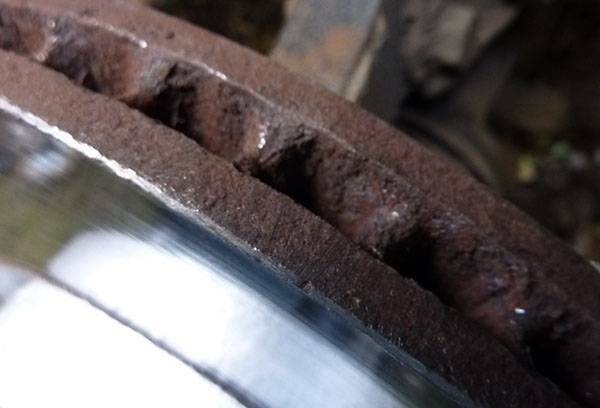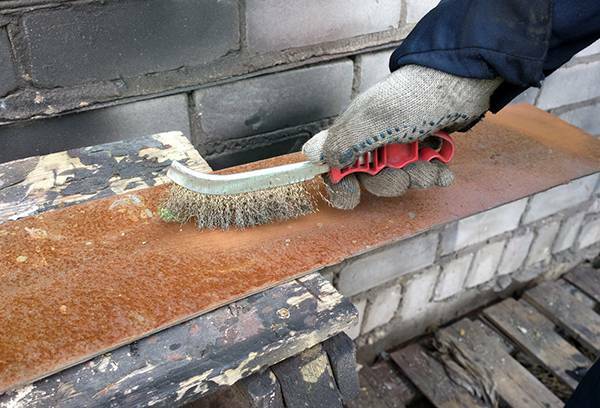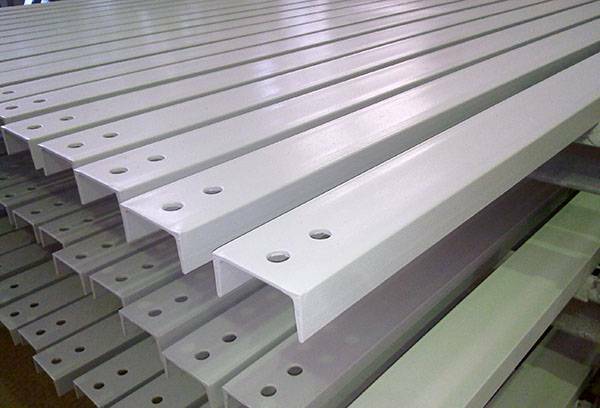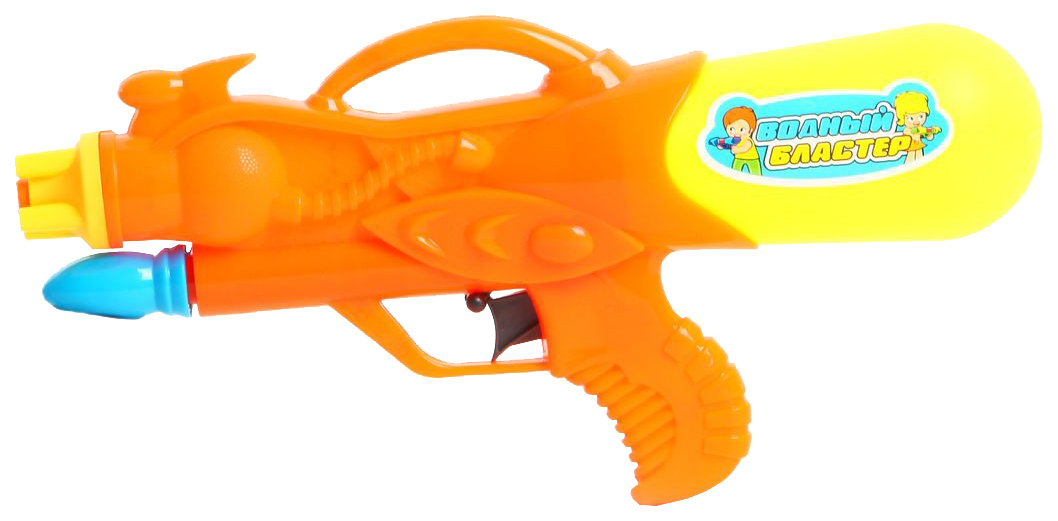Contents:
- Principle of operation of
- Where can not primer-modifier be used?
- Kinds of primers that can be applied to rust
- Surface preparation
- Application technology
- What is the priming consumption?
- Which primer to choose?
Anticorrosive primer, which is applied over rust, refers to modifier soils. It is used for the primary treatment of ferrous metal subjected to oxidation. After application, a rough, uniform surface is formed, which is covered with insulating primers.

Principle of operation of
The feature of primer-modifiers is the presence in their composition of rust converters. Most often it is orthophosphoric acid. The principle of operation is based on the fact that oxidation products( rust) react chemically with the components of the primer and are converted to non-oxidizable compounds. That is why anticorrosive primers can be applied over rust without cleaning the metal to a shine.
The converted oxides form an additional protective film on the surface with good adhesion properties, so that subsequent protective coatings adhere well to the treated metal. The above properties are especially important if it is necessary to treat surfaces in hard-to-reach places where it is problematic to remove rust completely.
All primers for rust have surfactants that increase the fluidity of the composition and improve its penetration to a thickness of up to 100 μm. However, loose, crumbling rust is not able to convert any chemical substance, so it must be cleaned, leaving only a hard-to-remove layer of oxides.

Where can not primer-modifier be used?
Ocalin is resistant to orthophosphoric acid, so it is not recommended to apply a primer containing a rust converter to such surfaces. If a black rust has formed on the surface, this indicates that the alloy contains magnetite, which is also resistant to modifiers.
Do not use rust modifying agents on surfaces where oxidation has occurred in part and most of it is metal without corrosion. Unpainted paint, like scale, will also not interact with the converter, and the primer can not penetrate it. If sulfur, hydrogen sulphide or ammonia compounds were exposed to metal structures during the operation, the use of an orthophosphoric acid based primer is also inadvisable.

Kinds of primers that can be applied to rust
At the moment, several types of anticorrosion primers can be found on the market.
- Primary, converting oxides and forming a thin film.
- 2 in 1 - performs two functions - primary primer and filler, creating a substrate with good adhesion under paintwork materials( paints).
- 3 in 1 - primary and secondary primer plus finishing coat( enamel).
Enamels 3 in 1 - a good option if the work needs to be done quickly. When using them, there is no need to select a secondary primer and paint. It is enough to apply 3 layers of such enamel, and it will perform several functions. Using primer enamel 3 in 1, it should be taken into account that the lack of step-by-step processing reduces the term of corrosion protection of metal to 5 years.
Advice
Combined treatment with application of primer and filler primer in compliance with the technology will protect the treated surface for a period of up to 20 years, so it is better to give this method of corrosion control. Primers for rust can be single-component and two-component. Two-component must be mixed immediately before use, introducing a hardener to the basic composition.

Surface preparation
All types of primers for rust have general surface preparation recommendations. It consists of several stages.
- Mechanical cleaning of metal from old layer of paintwork, scale and loose rust. At home, steel brushes or grinders are used for this, in industrial - sandblasters. In hard-to-reach places, you can use abrasive compounds with subsequent washing with water at a pressure of 6-8 atm.
- Sometimes, to clean old coatings and scale, a more suitable option is heat treatment. In this case, an oxygen-acetylene burner is used. This type of surface preparation is selected if it is necessary to remove rolling scale. In this case, cleaning by fire is more effective than mechanical cleaning.
- After cleaning from loose rust and old paint, the surface must be degreased. This can be done with any alkaline formulations or special rinses( solvents), depending on the type of stains on the surface.
- The final stage of the preparation is the stripping of the remaining water and drying. To remove moisture, use compressed air or scrapers for smuggling, drying is carried out either in special chambers or using a construction hair dryer.

Application technology
Application characteristics depend on the type of primer and are specified by the manufacturers. Two-component mixtures are mixed in the proportion specified in the instructions, and, if necessary, diluted to the working state with a diluent.
For both single-component and two-component soils, the diluent is selected on the basis of a binder:
- epoxy - ethyl acetate or xylene;
- pentaphthalic - solvent or "White Spirit";
- polyvinyl acetate - condensate( desalted water);
- polymeric( styrene) - solvent P 4, P 646.
In one-component formulations, up to 20% of the diluent is added. Bicomponents are brought to the desired viscosity after mixing with the hardener, the amount of diluent varies from 10 to 20%.After the desired viscosity is obtained, the primer is filtered through a funnel with a screen filter.
Prepared primer can be applied to the prepared surface with a brush, roller or spray. Small products of black metal can be processed by dipping. The feature of applying primary soils is that they are rarer, therefore, a nozzle up to 1.5 mm is used in the atomizer. The application layer should not exceed 15 μm. Visually, it should slightly translucent, and not completely cover the metal. Secondary soil can be applied no earlier than 20 minutes - this is the minimum time required for the reaction( transformation) and film formation.
For primers 2 in 1 or 3 in 1, a nozzle of 1.5-2 mm is selected. For working viscosity, a diluent is also added to them, but not more than 5% of the enamel volume. They are applied as well as primary soils, but the thickness of one layer is 40 μm. The treatment is carried out in two or three sets with an interlayer drying at 1 hour. The time for complete drying is 2-4 hours, depending on the humidity and air temperature.

What is the priming consumption?
The consumption of the primer-modifier largely depends on the condition of the surface to be treated. To calculate the required volume, you can focus on such indicators:
- Primary primer, in addition to compositions with an epoxy base, - 110-340 ml / m2 per layer;
- epoxy - 120-150 g / m2;
- 2 in 1 or 3 in 1 - from 80 to 150 ml / m2 per layer.

Which primer should I choose?
When choosing an anticorrosive primer, you need to determine the following parameters.
- Where will the soil be used - for external or internal work? For internal work, quick-drying compounds are chosen that do not contain toxic substances.
- Aggressiveness of the environment in which the processed product will be exploited. For aggressive media it is better to choose a soil of isolating type with good opacity and forming a dense film.
- Desired service life without additional treatments. If you want the steel product to last for many years, then it's better to stop on the primer. In the event that the main goal is to reduce labor costs, it is possible to purchase primer-enamel 3 in 1.


